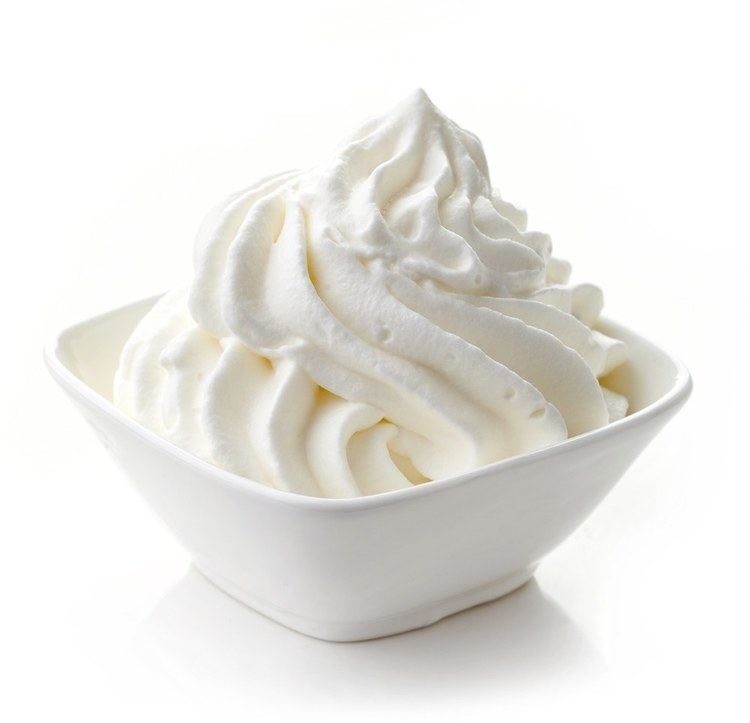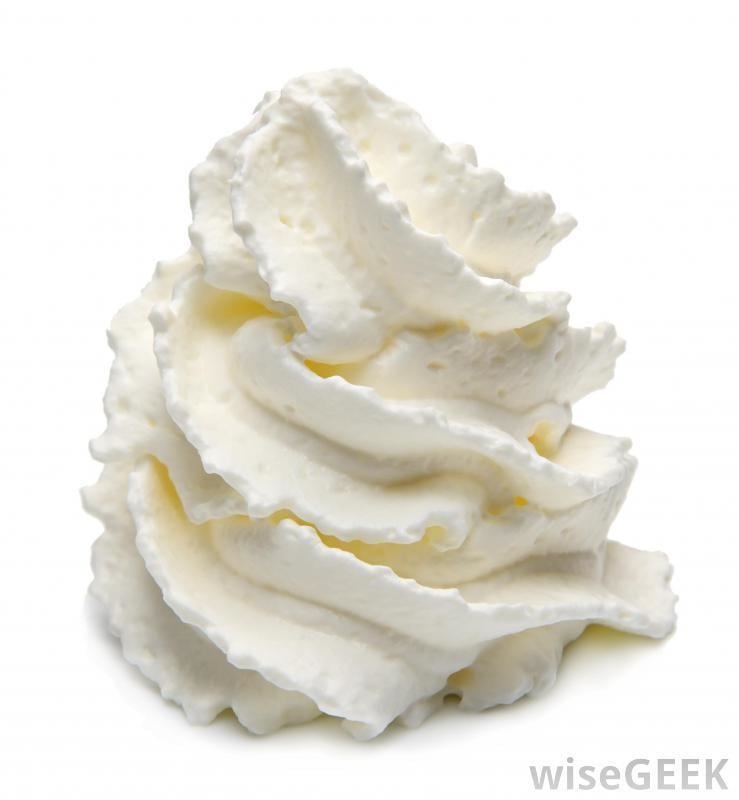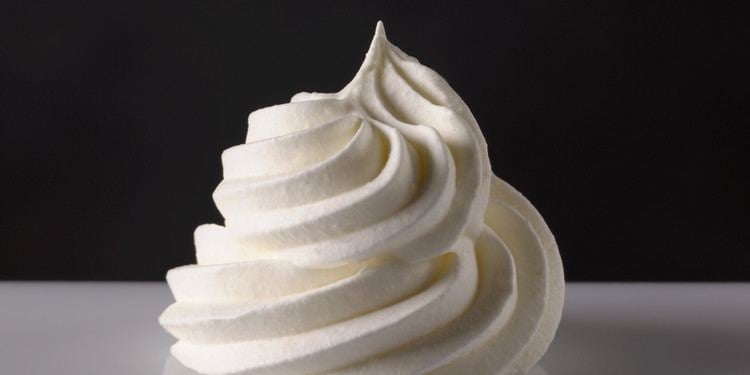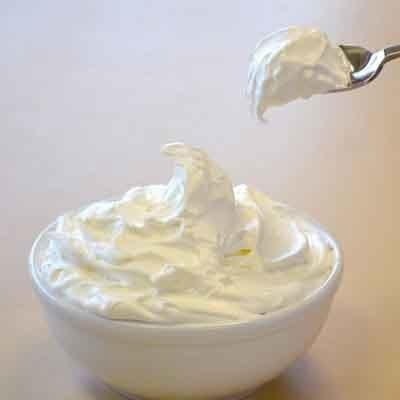Variations Chantilly cream | Main ingredients Cream | |
 | ||
Similar Sugar, Vanilla, Dessert, Chocolate, Butter | ||
Whipped cream from amul low fat 25 fresh cream perfect for anything
Whipped cream is cream that is whipped by a whisk or mixer until it is light and fluffy. Whipped cream is often sweetened and sometimes flavored with vanilla. Whipped cream is often called Chantilly cream or crème Chantilly ([kʁɛm ʃɑ̃tiji]).
Contents
- Whipped cream from amul low fat 25 fresh cream perfect for anything
- Whipped cream by tarla dalal
- Food chemistry
- Methods of whipping
- History
- Crme Chantilly
- Imitation whipped cream
- Uses
- References

Whipped cream by tarla dalal
Food chemistry
Whipped cream is an aerated colloid produced when air is incorporated into cream containing at least 35% fat. During whipping, partially coalesced fat molecules create a stabilized network which traps air bubbles. The resulting colloid is roughly double the volume of the original cream. If, however, the whipping is continued, the fat droplets will stick together destroying the colloid and forming butter. Lower-fat cream (or milk) does not whip well, while higher-fat cream produces a more stable foam.
Methods of whipping

Cream is usually whipped with a whisk, an electric or hand mixer, or a food processor. Results are best when the equipment and ingredients are cold.

Whipped cream is often flavored with sugar, vanilla, coffee, chocolate, orange, and so on. Many 19th-century recipes recommend adding gum tragacanth to stabilize whipped cream; a few include whipped egg whites. Various other substances, including gelatin and diphosphate (E450), are used in commercial stabilizers.

Whipped cream may also be made in a whipping siphon, typically using nitrous oxide as the gas, as carbon dioxide tends to give a sour taste. The siphon may have replaceable cartridges or be sold as a pre-pressurized retail package. The gas dissolves in the butterfat under pressure, and when the pressure is released, produces bubbles and thus whipped cream.
History
Whipped cream, often sweetened and aromatised, was popular in the 16th century, with recipes in the writings of Cristoforo di Messisbugo (Ferrara, 1549), Bartolomeo Scappi (Rome, 1570), and Lancelot de Casteau (Liège, 1604). It was called milk snow (neve di latte, neige de lait). A 1545 English recipe, "A Dyschefull of Snow", includes whipped egg whites as well, and is flavored with rosewater and sugar. (cf. snow cream) In these recipes, and until the end of the 19th century, naturally separated cream is whipped, typically with willow or rush branches, and the resulting foam on the surface would from time to time be skimmed off and drained, a process taking an hour or more. By the end of the 19th century, centrifuge-separated, high-fat cream made it much faster and easier to make whipped cream. The French name crème fouettée 'whipped cream' is attested in 1629, and the English name "whipped cream" in 1673. The name "snow cream" continued to be used in the 17th century.
Various desserts consisting of whipped cream in pyramidal shapes with coffee, liqueurs, chocolate, fruits, and so on either in the mixture or poured on top were called crème en mousse 'cream in a foam', crème fouettée, crème mousseuse 'foamy cream', mousse 'foam', and fromage à la Chantilly 'Chantilly-style cheese'. Modern mousses, including mousse au chocolat, are a continuation of this tradition.
Cream whipped in a whipping siphon with nitrous oxide was invented in the 1930s by both Charles Getz, working with G. Frederick Smith, and Marshall Reinecke. Both filed patents, which were later litigated. The Getz patents were originally deemed invalid, but were upheld on appeal.
Crème Chantilly
Crème Chantilly is another name for whipped cream. The difference between "whipped cream" and "crème Chantilly" is not systematic. Some authors distinguish between the two, with crème Chantilly being sweetened, and whipped cream not. However, most authors treat the two as synonyms, with both being sweetened, neither being sweetened, or treating sweetening as optional. Many authors use only one of the two names (for the sweetened or unsweetened version), so it is not clear if they distinguish the two.
The invention of crème Chantilly is often credited incorrectly, and without evidence, to François Vatel, maître d'hôtel at the Château de Chantilly in the mid-17th century. But the name Chantilly is first connected with whipped cream in the mid-18th century, around the time that the Baronne d'Oberkirch praised the "cream" served at a lunch at the Hameau de Chantilly—but did not say what exactly it was, or call it Chantilly cream.
The names "crème Chantilly", "crème de Chantilly", "crème à la Chantilly", or "crème fouettée à la Chantilly" only become common in the 19th century. In 1806, the first edition of Viard's Cuisinier Impérial mentions neither "whipped" nor "Chantilly" cream, but the 1820 edition mentions both.
The name Chantilly was probably used because the château had become a symbol of refined food.
Imitation whipped cream
Imitations of whipped cream, often sold under the name whipped topping or squirty cream, are commercially available. They may be used for various reasons:
Whipped topping normally contains some mixture of partially hydrogenated oil, sweeteners, water, and stabilizers and emulsifiers added to prevent syneresis, similar to margarine instead of the butter fat in the cream used in whipped cream.
Uses
Whipped cream or crème Chantilly is a popular topping for fruit and desserts such as pie, ice cream (especially sundaes), cupcakes, cake, milkshakes, waffle, hot chocolate, Jello and puddings. It is also served on coffee, especially in the Viennese coffee house tradition, where coffee with whipped cream is known as Melange mit Schlagobers. Whipped cream is used as an ingredient in many desserts, for example as a filling for profiteroles and layer cakes.
